We recently conducted the largest MyDogLikes reader survey to date (with hundreds of responses) and learned some very interesting facts about the collective health of our pets.
We all want our dogs to be as healthy as possible. Unfortunately there are a lot of things that can go wrong. The good news is that many of the most common dog health problems can be prevented or at the very least improved with a greater knowledge and understanding of the underlying conditions.
We conducted this poll for 3 main reasons:
- To get a greater idea of the issues faced by our readers. This will help us to create content that can serve you better. By finding out the questions you have, we will be able to seek out the best possible solutions.
- To share the knowledge we have gained thus far along our journey. We have come a long way in our journey as pet parents. Though we still have much to learn, one of our main goals is to share what we have learned and hopefully help improve the lives of pets everywhere.
- To let you know that you are not alone! It is very likely that another member of the MyDogLikes community has faced a similar situation with their animals. We share all that we can here on the blog, but wouldn’t it be nice to be able to ask/answer questions and share knowledge in a more connected way? That is why we recently created, and would encourage you to join our private Facebook community for dog lovers!
As we dive into the results of our survey below, we will also look into potential causes and solutions – focusing particularly on a company that we are proud brand ambassadors for and that has made a huge difference in the lives of our dog’s: Dr. Harvey’s.

MyDogLikes 2016 Dog Health Survey Results
What follows are the results of our 2016 Health survey, along with a bit more information on each dog health issue and information that may be beneficial to those suffering.
I Would Describe My Dogs Coat As…
While the majority of readers described the condition of their dog’s coat as just right, 36% thought that their dog suffered from a dry coat. While there are a lot of potential causes and solutions for this issue, diet is often the easiest answer of all.
We always remind ourselves that health starts in the kitchen (or what’s in your dog’s bowl) and this couldn’t be more true for your dog’s largest organ – their skin and coat. Healthy skin and coats begins with feeding your dog a diet that is rich in high quality protein. According to PetMD, fur consists of around 95% protein and 25-30% of the protein that a dog consumes is used to support their skin and coat. Unfortunately, it is all to common to see commercial kibble that is chocked full of low quality proteins such as “chicken by-product”, “chicken meal”, and cheap fillers such as corn: ingredients which may not meet your dog’s unique nutritional needs.
Along with a healthy diet, fish oil and coconut can also be very helpful in promoting a healthy and shiny coat. But remember, no supplement will take the place of a high quality food!
Does your dog frequently suffer from loose stools, diarrhea or constipation?
Elimination can be one of the most telling signs of distress in a dog’s digestive system, and this can manifest itself as constipation, loose stools, or diarrhea.
The most common issue described by our readers was loose stools. While this can be a symptom of poor digestion, it is most commonly the result of a poor diet. The majority of commercially available dog diets are loaded with fillers, severely lacking in nutrition and contain plenty of questionable ingredients. Even premium brands are not ideal since kibble by definition is highly processed and low in moisture. This is tougher on a dog’s digestive tract than whole foods.
We have talked quite a bit about our journey to Dr. Harvey’s in the past, and how it was a step-by-step process. As we learned more and more about dog nutrition, we kept trying higher and higher quality kibble because let’s face it – it is inexpensive, and very convenient! However, we were never satisfied with the results until we finally made the switch to a Dr. Harvey’s inspired whole food diet. Since the switch, our boys have been incredibly regular and have had absolutely no issues with digestion. Their stools are smaller, more firm and less odorous than before.
For those who aren’t ready to make the switch or have a more difficult problem with elimination, there are supplements that can help. For example, Dr. Harvey’s Runs-be-Done is designed to soothe the digestive tract and help keep stools solid. It comes in a convenient powdered form that can be sprinkled right on top of your dog’s current food.
I would best describe my dog’s activity level as…?
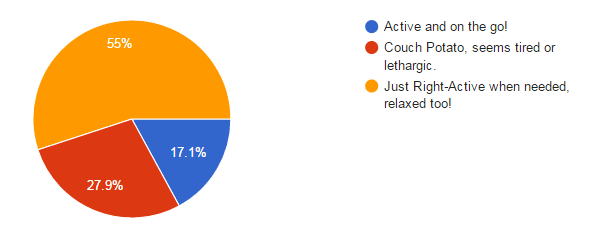 While the majority of our readers described their dogs activity level as just right, we had a great deal of responses depicting their pups as a couch potato. Don’t feel bad, we have been through this issue as well, before we made a serious commitment to daily walks.
While the majority of our readers described their dogs activity level as just right, we had a great deal of responses depicting their pups as a couch potato. Don’t feel bad, we have been through this issue as well, before we made a serious commitment to daily walks.
While its normal for dogs, like humans, to slow down a little as they age, there are some tell-tale signs that the slowdown that you observe may be due to other facts like diet, and not a related to aging. For starters, lethargic dogs may tire easily, sleep a lot, and be reluctant to engage or lose enthusiasm for activities that they used to enjoy (walks, car rides, etc).
We were shocked at the role that diet played in Harley’s sleepiness and lack of enthusiasm. Since making the switch to a homemade dog food we have seen a tremendous change in Harley’s energy levels. As a nearly 10 year-old, he walks a little slower and takes more time to get up when he has been laying around, but is now just as enthusiastic as ever when it comes to eating, taking walks, going for rides, and getting treats. He even randomly gets the zooms around the house, whines to go for walks (or for us to stop working and play with him), and (for better or worse) has started jumping on us again. NAUGHTY BOY!
I would describe my dogs weight as…?
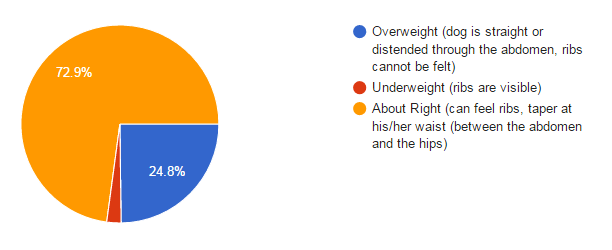 Nearly a quarter of respondents that answered this question expressed a desire for their dogs to lose weight. This was not entirely surprising to us as many dogs are overfed and under-exercised (just like their busy moms and dads!).
Nearly a quarter of respondents that answered this question expressed a desire for their dogs to lose weight. This was not entirely surprising to us as many dogs are overfed and under-exercised (just like their busy moms and dads!).
While puppy dog eyes can be awfully hard to say no to, research says that your dog will live a longer and healthier life by maintaining a healthy weight. They may not understand why I say no to more treats or table scraps, but looking into those big, beautiful brown eyes for longer, is all the justification that I need. In addition to saying no to scraps and extra treats there are some simple ways that you can help your dog to stay fit and trim.
Tips for Dog Weight Loss
- Use the recommended serving size on the bag as a GUIDE. There are many factors that go into caloric requirements and while some dogs do very well using basic size and activity calculations, others do not.
- Always measure or weigh your dogs food. Weigh your dog regularly to see how their weight responds and adjust the amount you feed according to size, activity, and other health needs.
- Cut back on food slowly and add healthy snacks like carrots or green beans that are low calorie but can still help your dog to feel full during the transition period.
- Plan ahead for treats, don’t let it be a spur of the moment decision.
- Exercise, and add more time or distance as their physical fitness improves. Commit to a schedule and stick to it!
Does your dog have unpleasant odors coming from his/her ears or mouth?
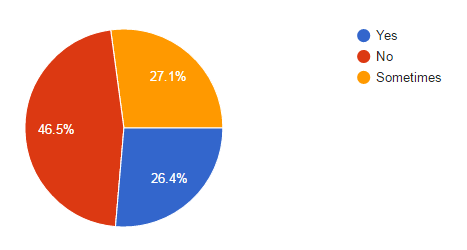 Odors emanating from your dog’s mouth or ears are typically a sign that something else that is going on. These foul smells can be caused by decay or infection. Both bad breath and infected ears can also be the result of a poor diet.
Odors emanating from your dog’s mouth or ears are typically a sign that something else that is going on. These foul smells can be caused by decay or infection. Both bad breath and infected ears can also be the result of a poor diet.
While it is always important to consult your veterinarian and rule out other causes, taking a “whole-dog” approach to health will naturally lead you back to questioning some of the proactive steps you can take for improving their oral and ear health. In addition to feeding a healthy diet that can reduce inflammation and boost your dog’s immune system the following are some simple steps that can be taken to improve these stinky problems!
Oral Health
|
Ear Health
|
Does your dog frequently paw or scratch at his/her ears or face?
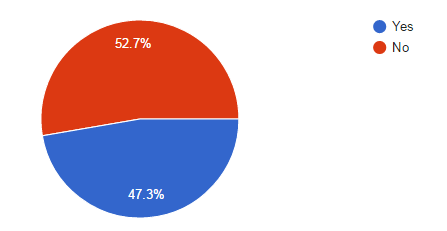 Allergies are unfortunately an all too common issue among our pets. As reported, 47% of pet parents report that their dogs are suffering from some type of allergic reaction that is causing them discomfort.
Allergies are unfortunately an all too common issue among our pets. As reported, 47% of pet parents report that their dogs are suffering from some type of allergic reaction that is causing them discomfort.
While there can be many reasons for itching including nutrition, environment, parasites, allergies, and infection, careful observation of your dog itching behavior can help to pinpoint a potential source to their discomfort. How? Perhaps you’ve noticed your dog itching his/her face and ears after eating (allergens/nutrition), playing in the grass (environment), or in response to fleas (parasite)?
High quality food can work wonders for relieving the symptoms of dog allergies. One of the reasons that we love Dr. Harvey’s is because it allows you to customize the macronutrients that are right for your dog and their specific circumstances. With pre-mix options like Veg-to-Bowl and Canine Health, you are even adding your own protein so have the freedom to customize due to allergy concerns.
Does your dog have difficulty moving around?
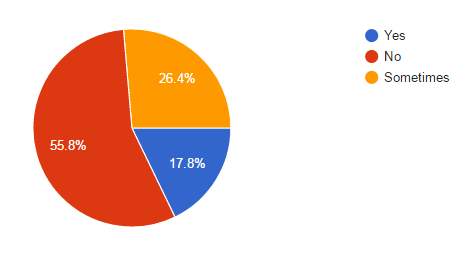
While pain and mobility issues are sometimes due to excessive weight, they can also be the result of more serious conditions like arthritis or dysplasia. Either way, this difficulty moving around can often be improved with a careful routine of diet and exercise.
Many foods such as grains and nightshades (potatoes, tomatoes, eggplant) have been shown to worsen arthritic symptoms. On the other hand, dark vegetables and fruits like kale and blueberries can help.
There are also a wide variety of supplements on the market to help improve joint health utilizing compounds like glucosamine, chondroitin, and Omega 3 & 6 fatty acids. Dr. Harvey’s has their own powdered joint supplement called Ortho-flex which is based upon traditional herbal remedies to help relieve joint pain and stiffness.
The Dr. Harvey’s Difference – A Reader Testimonial
As you can see, there are a lot of common dog health problems faced among our readers. We always recommend exploring a natural solution to these issues whenever possible, and diet is the most logical place to start. We are firm believers in the power of a healthy diet to not only alleviate symptoms but often eliminate problems entirely.
You may recall that as a part of this health survey, one lucky reader was going to win a supply of Dr. Harvey’s Dog Food to see if it would help improve their quality of life.
Well, we wanted to give you a quick introduction to the winner, Nala!
Nala’s mother explained that she has food allergies and environmental allergies. She has also had issues with dry skin and coat.
Stay tuned for next month, where we will check in and see how sweet Nala is doing on her new diet!
Save 10% on any Dr. Harvey’s order with code “MDL1231”

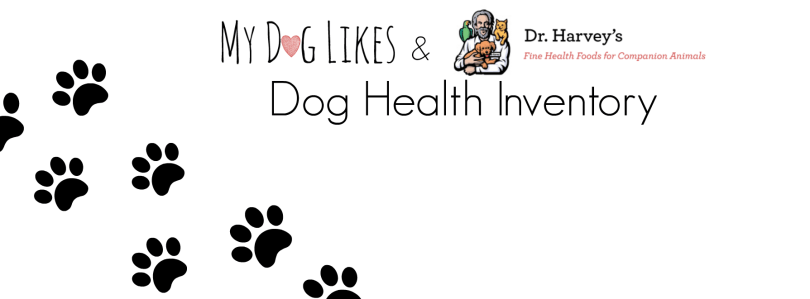
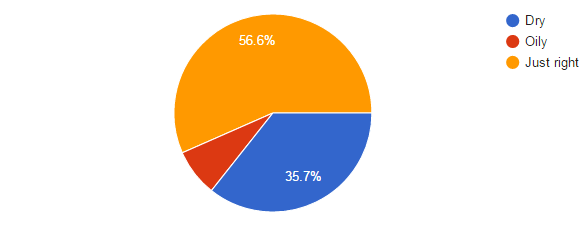
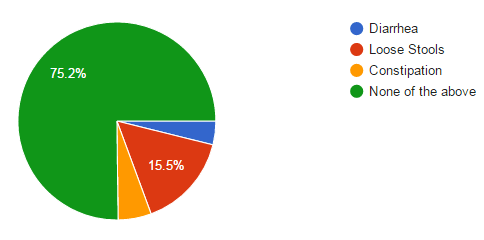
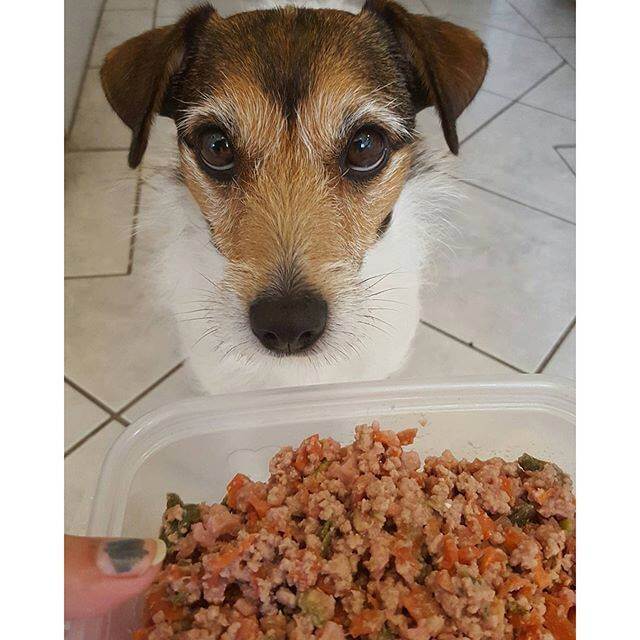

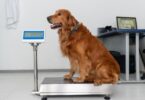


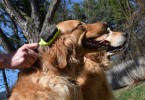

VERY interesting information! I love the pie charts for giving a visual of the results; it makes them so much more tangible. Excited to find out next month how pretty Nala is doing on her diet! Thanks for sharing!
This was a very thorough survey. I’ve always been a bit obsessive about making sure my dogs are a good weight and not overweight, and recently I’ve been focusing on their dental health.
Great tips for all dog parents. Thanks!
I guess I’m relieved to see that only about 25% of dogs in the survey are overweight. I think other surveys have put the percentage of overweight or obese dogs at a higher number. It still saddens me though. I wish all dogs were at an ideal weight.
Gretel was recently diagnosed with a spinal disease common in Dachshunds. We’ve been told over and over again that her healing is likely to go quicker and easier because she is fit. Usually the first thing a vet has to suggest for a dog with this condition is that they lose weight. You know how almost impossible it is for a dog to lose weight when part of their treatment is 6 – 8 weeks of being confined to a dog crate?!? It makes me proud that Gretel will have an easier time with her condition because how diligent I’ve been about moderating her weight.
Super interesting and great visuals! I’m curious about age and where things would land along the way! Thank you for sharing – we appreciate it 🙂
Great post! I love the breakdown of information into pie charts – extremely helpful for us visual learners.
My senior girl, turning 13 this month, struggles with weight management from an underlying condition called malignant hyperthermia (she can’t regulate her own body temperature, making it very difficult to exercise her properly without her overheating) and arthritis and I am always looking for ways to address both and appreciate your thoughts on both. Thanks for sharing all of this great information.
What a great and interesting survey! I love the pie chart 🙂
I had no idea that Dr. Harvey’s had a joint supplement! Thanks for sharing.
How interesting!
Very interesting study among your readers!
Those are some interesting questions and answers. Great idea to take a survey.
Love the way you displayed the results! It is amazing to see the how feeding a better quality and less processed food can help a dog have better skin, coat, digestion, and energy level.
This is interesting! I’ve found that changing my dog’s food really helped her with her allergies.
This is a great post, and I love the pie charts! I am pretty much obsessed with Shadow’s and Ducky’s weight, so am happy to see I’m not the only one. Since poor Shadow has arthritis in both elbows and wrists – though it’s worse in her right elbow and wrist than her left ones – she still loves to run around the yard, chasing the ball, Ducky, and squirrels. But when I call her to come inside with me, she walks like a little old lady. 🙂 I’ll have to check out Dr. Harvey’s food for her because she has become very picky about what she will and won’t eat since Callie became a fur angel.
Thanks for a great post – we’re huge Dr. Harvey’s fans.